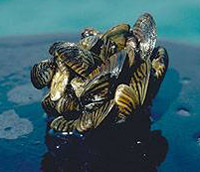A technique to kill invasive aquatic species found in the ballast water of Great Lakes ships made its real-world debut on a vessel traveling from Gary, Indiana to Duluth, Minnesota recently.

The Duluth News Tribune has the story HERE.
Scientists led by Isle Royale National Park superintendant Phyllis Green are using sodium hydroxide to kill zebra mussels and other species that are transported in ship’s ballast and then neutralizing the treated water with carbon dioxide before release back into the environment.
After three years of laboratory study, the method was tested on the Great Lakes cargo ship Indiana Harbor. Sodium hydroxide was pumped into two of the ship’s 10 ballast tanks as it left Gary, treating 1.8 million gallons of ballast water. En route, carbon dioxide was added to the ballast, neutralizing it before it was released into the waters of Duluth Harbor.
Samples from the test are being analyzed to see how effective the biocide was at killing organisms and how effective the carbon dioxide was at neutralizing the ballast water afterward. Previous tests at shore stations found that 98 percent of organisms were killed within 2 hours of treatment.
Invasive species cause an estimated $5.9 billion in damage to the Great Lakes every year.

